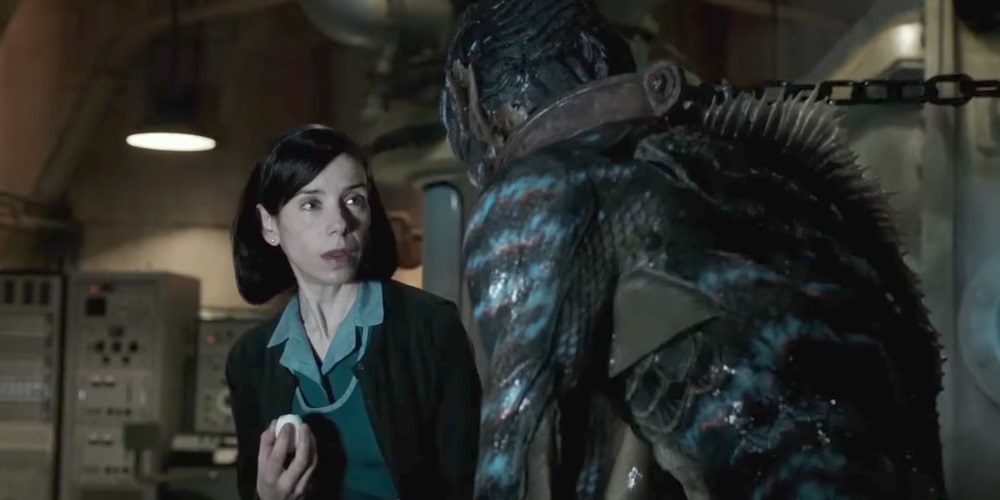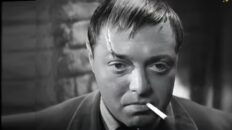“People pay for what they do, and still more for what they have allowed themselves to become. And they pay for it very simply; by the lives they lead.” ― James Baldwin
***
I have a theory about the correlation between the trailers that play before a feature and the film. Namely, the more diverse the trailers are, the more unclassifiable the film is. Before my screening of The Shape of Water, were trailers for comedies, horror films, dramas, action, a Western, and fantasy films. (I love watching trailers on the big screen, but almost half an hour of trailers is excessive.) What is The Shape of Water, director Guillermo del Toro’s latest film? Is it a love story? A cold war spy flick? A creature feature? Yes to all these and more. Drawing from the same well that informed Giuseppe Tornatore’s Cinema Paradiso and Martin Scorsese’s Hugo, The Shape of Water blends in elements from B-list horror films like The Creature from the Black Lagoon by way of H.P. Lovecraft, musical and dance numbers similar to the way the Coen Brothers did in Hail, Caesar!, and aspects of fantasy, spy, and romance genres. It’s sweet and sentimental and charming, for all its rough edges and sometimes uncomfortable subject matter, in a way we haven’t quite seen from del Toro before.
Sally Hawkins (Godzilla, Paddington) radiates as mute Elisa Esposito, a cleaning lady at a government research facility who becomes captivated by the facility’s latest asset, a fish-man (Doug Jones) captured in South America by Richard Strickland (Michael Shannon). That Elisa feels a kinship and attraction to such a grotesque specimen isn’t such a surprise. Being mute, she has been relegated to the edges of society, counting among her friends her landlord―a theater owner―who gifts her with film tickets hoping to fill seats, her neighbor Giles (Richard Jenkins)―a sensitive, closeted, even to himself, homosexual―who struggles as an artist, and her co-worker Zelda (Octavia Spencer) who labors and lives under the knowledge and weight that only a person of color can really understand in America in the early 60’s.
While Elisa forms a bond with the creature, Strickland literally pokes and prods the thing and argues with scientist Dr. Robert Hoffstetler (Michael Stuhlbarg) over the best way to study it. Hoffstetler catches Elisa communicating with the creature one day with sign language and music and realizes it is not merely some previously unknown species of animal, but has self-awareness and the ability to interact and converse. In other words, it is a sentient being. But Hoffstetler isn’t just a man of science, he’s also a Russian agent―and the Russians are just as interested in what this being’s capabilities could offer their programs as the Americans are.
What follows is a cacophony of genres colliding in aims: an escape thriller as Elisa enlists the aid of her neighbor Giles to rescue the creature, an espionage drama as Hoffstetler races to steal or destroy the asset, a love story with doomed leads grasping for a measure of connection and shared joy―all competing to lift the creature from certain death at the hands of Strickland. What’s interesting about the structure of the film is that this climax happens just past the midway point, allowing time for the characters to live in and inhabit the choices they make in relation to the creature before finally drawing to a close. We are allowed to see the characters pay for what they do―pay in good ways and bad.
It’s hard not to read Michael Shannon’s Strickland as a type of sexual abuser―both in the way he treats and makes love to his wife and how he abuses his position of power, exposing his manhood in front of Elisa and Zelda, and making direct sexual overtures to Elisa―pulled from current headlines. But it’s startling to realize that the film was written, shot, and edited before the current wave of headlines over sexual abuse by men in power became household news. Strickland also embodies a certain kind of power that might be described as fascist in the sense that it wants everything to be simple and clearly delineated between successful and not, reliable or useless, in black and white―from candy and cars to assets and people. Yet what plagues so many similar characters―in fiction and real life―haunts Strickland as well: an obsession, a desire to control, a fetish for what he does not understand. How can something thrive, let alone exist, in a state of being that he can not relate to?
Toward the end of the film Strickland, confronting the amphibious humanoid, declares, “You are a god!” This both cements the Lovecraftian influence on the film, taking it out of just B-film creature feature references and places it firmly in Lovecraft’s domain where aquatic, alien humanoids were not just monsters, but a type of god, as well as, in the context of this story, brings to mind Jesus’s quote from the Gospel of Matthew, “whatever you did for one of the least of these brothers and sisters of mine, you did for me.” Whether one subscribes to the Christian tradition of seeing God in the homeless, in the immigrant, in the fatherless, in the widows, in the least of those among us or not, the idea that we can see god or something greater than ourselves in the oppressed and strange-to-us and struggling is a profound concept.
Ultimately, The Shape of Water is a fable, one crafted with obvious love and care by del Toro who doesn’t shy away from depicting small, simple joys even as it wrestles with greater injustices―and indeed even asks its audience to question why we love our small joys and indulgences (compare Giles’ love of pie to Strickland’s love of hard candy and what they symbolize for each character). The Shape of Water may be del Toro’s most challenging film yet, sure to polarize audiences regarding its subject matter and the stance it takes in regard to certain social issues, but also so full of hope, joy, and love it’s impossible to not appreciate.









